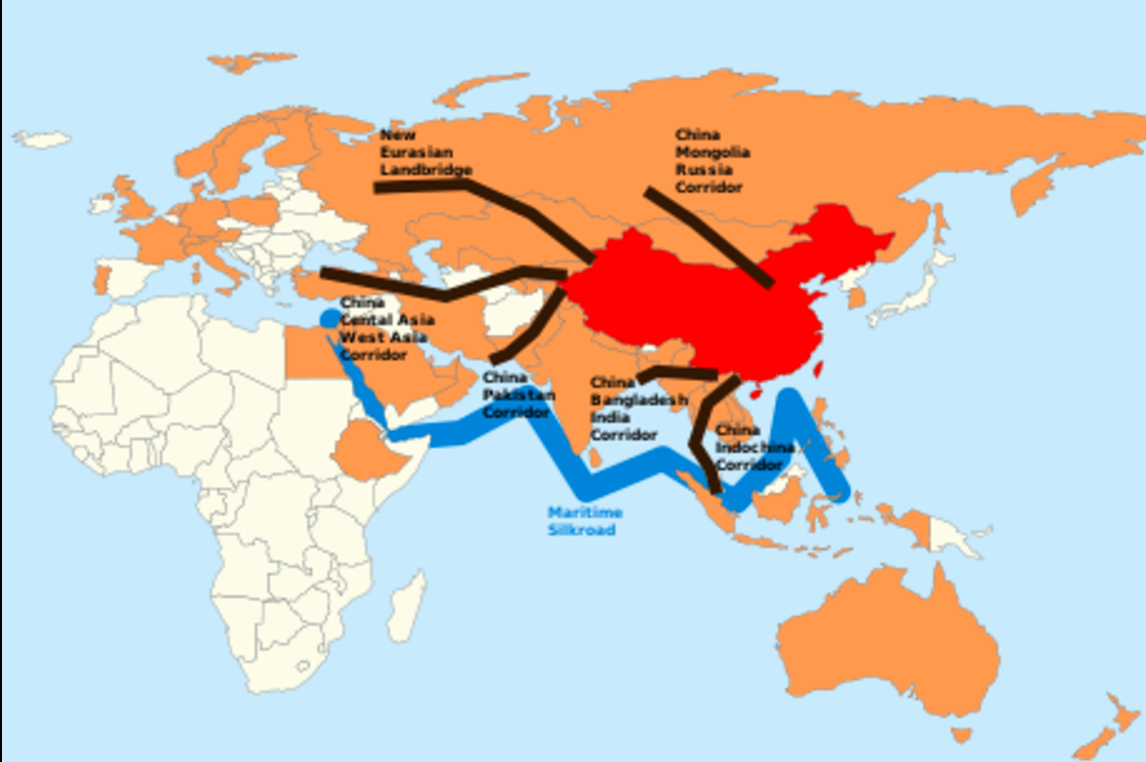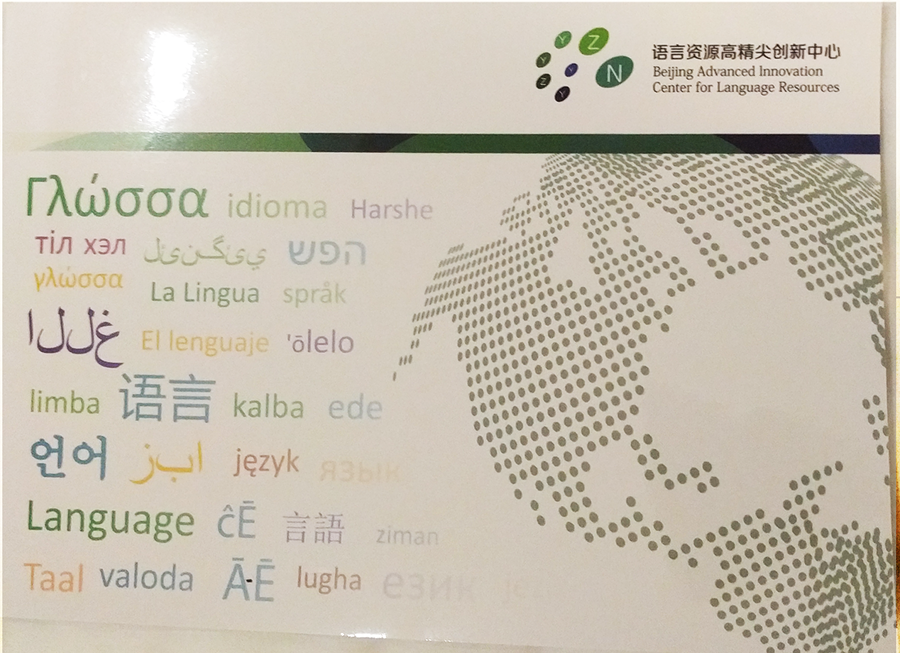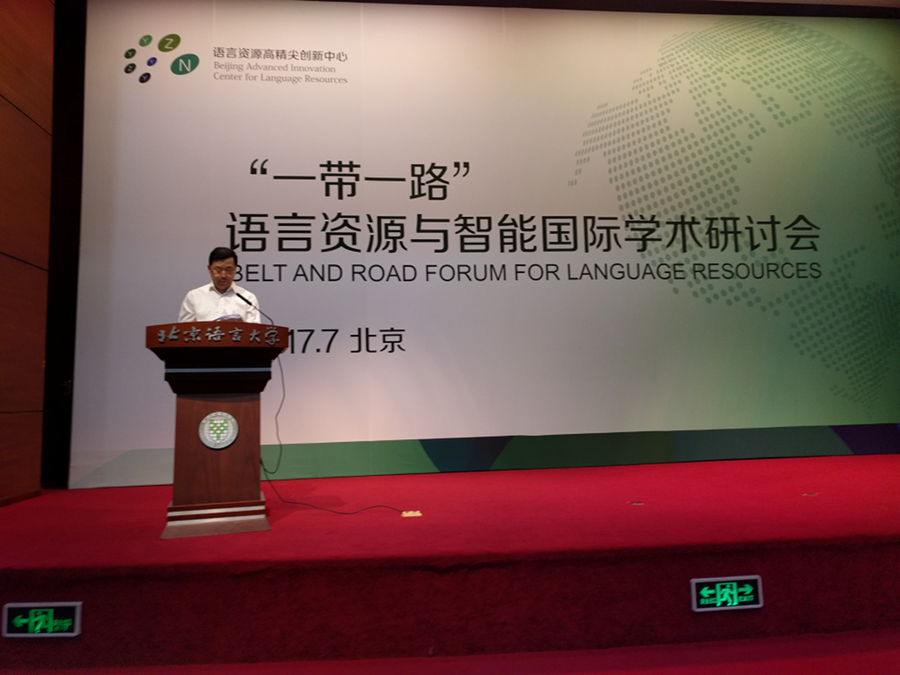North America on the Belt and Road?
« previous post | next post »
I've spent the past couple of days at the "Belt and Road Forum for Language Resources", organized by the "Beijing Advanced Innovation Center for Language Resources". There are other recently-founded Beijing Advanced Innovation Centers for "Future Education", "Genomics", "Soft Matter Science and Engineering", "Intelligent Robots and Systems", "Big Data and Brain Computing", "Future Visual Entertainment", and no doubt many others.
As for the "Belt and Road Forum" part, this is part of the "Belt and Road Initiative" (discussion e.g. here), which Christine Lagarde said "is about connecting cultures, communities, economies, and people, and about adding new economic flavors by creating infrastructure projects that are based on 21st-century expertise and governance standards". The "Belt" seems to be a set of land-based transportation projects, while the "Road" is the "Maritime Silkroad", all centered on China as illustrated here:
One thing that puzzled me about this workshop was its thematic image of an artistically pixelated globe centered over the North Atlantic, roughly at the latitude of Philadelphia.
Here's an example from the cover of the Center's brochure:
And another from the backdrop on the stage in the auditorium:



J said,
July 16, 2017 @ 4:32 am
This is a common template in many Chinese computers. I assume it connotes"international" to many Chinese.
flow said,
July 16, 2017 @ 5:45 am
Looks like another entry to the Subreddit for Arabic Lettering Gone Wrong. I don't speak, write or read any language in that alphabet, but according to Google Translate, اللغة allugha may have been what they intended to write. Also, the smaller and longer word in the second row has the same defects; judging from the letter گ, that *might* be Persian, but I couldn't find a suitable translation going from left to right or from right to left.
Victor Mair said,
July 16, 2017 @ 6:39 am
From Brian Spooner, on the Arabic script writing:
They are letters of the Arabic script, but they are written unconnected, which (so far as I know) no Arabic script writer in whatever language would ever do:
y y gn w l the gn are connected, and the w could be a v or a u
gh l l a the a could be a glottal stop
a b z again the a could be a glottal stop
These combinations don't suggest any words to me in Arabic, Persian, Urdu or Pashto, or even Turkic. Strange.
Yerushalmi said,
July 16, 2017 @ 7:16 am
The Hebrew word for "language", שפה, is reversed letter-for-letter in the brochure.
Alexander said,
July 16, 2017 @ 7:39 am
Even the Latin alphabet: what's ĉĒ and Ā-Ē? (And why is the hyphen [or middle dot?] darker than the letters in the latter?)
flow said,
July 16, 2017 @ 8:26 am
Truly advanced innovative language resources.
greg said,
July 16, 2017 @ 9:34 am
@Alexander my immediate suspicion is that it is mojibake. The Arabic/Hebrew errors would seem to suggest that the translations were pasted from some source directly into the program used to make it, so it's plausible the error was introduced then.
Victor Mair said,
July 16, 2017 @ 10:21 am
The language people in China know that the LDC is located in Philadelphia!
The overall, long-range planners of the BRI (that's the official designation since mid-2016, but the project is still better known among China Studies specialists as OBOR (see here, here, here, here, and here) would like to include the whole world within the of OBOR's tentacles. (Here's the very cute Tentacle Kitty, whom I think everybody should know about.)
The language, politics, and economics of the BRI were recently discussed on Language Log:
"BARF (Belt and Road Forum)" (5/19/17)
"BARF (Belt and Road Forum) 2.0" (5/20/17)
Those two posts were made at the height of the OBOR euphoria just after the grand Beijing Belt and Road Forum (May 14-15, 2017) was concluded.
I have a feeling that this post is going to garner a lot of attention, because it is the first notice that bruits the possibility that North America may be thought of as part of OBOR / BRI in a systematic manner (that had already been sporadically hinted at elsewhere in a more tentative fashion, e.g., here and here).
Now, what does the Chinese on the panel / projection behind the speaker in the last photograph say?
=====
"yīdài yīlù 一带一路" ("One Belt One Road", i.e., "OBOR")
Yǔyán zīyuán yǔ zhìnéng guójì xuéshù yántǎo huì 语言资源与智能国际学术研讨会 ("International Symposium on Language Resources and Intelligence")
=====
They left out an important word in the name of the symposium, namely, zhìnéng 智能 ("intelligence"). I can understand why they just forgot about it, because it's hard to translate without sounding a bit silly. But what the word is probably supposed to evoke is its usage in the expression réngōng zhìnéng 人工智能 ("artificial intelligence").
Finally, to return to the "thematic image of an artistically pixelated globe centered over the North Atlantic, roughly at the latitude of Philadelphia" with which Mark ends the o.p. It is noteworthy that, not only is the map centered on the North Atlantic at the latitude of Philadelphia, it entirely omits China. That is extremely bizarre, because Chinese cartographers usually never miss an opportunity to put their country at the center of world maps — unless we look at it from another perspective.
The pixelated map of the globe has its central focus smack dab between North America and Europe (which is poorly represented). If we think about this map in comparison with the spiral above it, we can begin to make some semiotic sense of the two together.
The letters inside the little circles that make up the spiral are Y Y Z Y Y Z N. They stand for Yǔyán zīyuán yǔ zhìnéng 语言资源与智能 ("Language Resources and Intelligence"), the first half of the name of the symposium. What is the symbolic significance of the spiral logo and pixellated globe together?
North America and Europe are where the Industrial Revolution and the Electronic Revolution (not William Burroughs' collection of essays!) took place during the last two and a half centuries. China may lie outside the essential framework of these transformative revolutions, but the motion of the spiral goes from the center clockwise and ends up emphatically upon the spot where China would be located if the whole circle of the pixelated globe were shown. The "N" circle is much larger than the other circles leading up to it, so it is the terminus toward which things are headed.
In the minds of the convenors of the symposium, how are we going to get there? Through linguistics and AI, which is not at all an unreasonable projection for where humanity is going during the next two and a half centuries — though the geographical end point may not necessarily be located in China, but it is all right for the Chinese to hope that it will be. If they want the center of human gravity to be in China, it's up to them to make it happen by doing the right things, especially in linguistics and AI (I agree with them that these will be key driving factors in human development for the next couple of centuries, though not the only ones — the pure and applied sciences certainly cannot be ignored).
In international codes (e.g., IATA, ISO, etc.), China is represented by "CN", and in some cases by "ZH" (for Zhōngguó 中国). Forgive me for being too Buddhistic and Sanskritic in my orientation, but when I see ZN, I can't help but think of Zhīnà 支那 ("China"), a name that was still in use during the first half of the 20th century and has roots going back more than two millennia.
See:
"The transcription of the name 'China' in Chinese characters" (6/17/12)
"'People's Re-fu*king of Chee-na'" (10/12/16)
Alexander said,
July 16, 2017 @ 11:07 am
@greg You're probably right. On the other hand it could be a new hybrid of Esperanto, Latin and Lojban under development as the ultimate universal language.
Neil Dolinger said,
July 16, 2017 @ 12:20 pm
President Xi, just like Tentacle Kitty, just wants to give the whole world a hug!
Victor Mair said,
July 16, 2017 @ 12:45 pm
Speaking of AI,
"Elon Musk: Artificial Intelligence Is Society's 'Biggest Risk':
The Tesla and SpaceX CEO urged governors to regulate artificial intelligence before it's too late."
By Casey Leins, Staff Writer | July 16, 2017, at 10:31 a.m.
https://www.usnews.com/news/national-news/articles/2017-07-16/elon-musk-artificial-intelligence-is-the-biggest-risk-that-we-face-as-a-civilization
This is a big surprise, coming from a renowned advocate of creative science.
Y said,
July 16, 2017 @ 12:49 pm
Can I please call for a moratorium on banners, coffee-mugs, hostel walls, etc. showing one word ('love', 'language', 'coffee', etc.) written in lots of languages (most of which the writer doesn't actually know)? Objectively, it's error-prone, as here. Subjectively, it's super cheesy.
Matt Keefe said,
July 16, 2017 @ 1:36 pm
The Arabic is اللغة written left-to-right with the final character missing, surely?
Matt Keefe said,
July 16, 2017 @ 1:43 pm
In fact, the same would answer the Urdu – ا ب ز was probably intended to be زبان, with the final letter again omitted and the whole word rendered backwards. When I was first learning to type in the Arabic script I'd often struggle to locate the cursor at the end of a word so would often end up missing the final character when highlighting for cutting or copying and pasting. I think the same could well have happened here to someone unfamiliar with the scripts and languages concerned taking them from Google Translate or the like.
Victor Mair said,
July 16, 2017 @ 2:36 pm
From Joe Lowry:
I can't make sense of them as they are, but I would guess that they are misspellings of the words for "language" in Arabic, Persian, and maybe Urdu. They have a problem that I sometimes get when someone sends me an Arabic Word document that is created on a PC (I have a Mac), which is that the letters become disconnected. But–if I'm right–they also seem to be going left to right when they should be right to left.
I'm not sure what the top (Urdu) word is, but it has the letters lyyngy–and it could be Persian. However, I don't think it's Persian because the bottom of the three words looks like a misspelling of the word zabān (زبان ), though it is missing the n. That leaves the middle word, which looks like a possible misspelling of the word ( اللغة ) but is missing the final tā’ marbūṭa ( ة ). It seems that there is a pattern for the Arabic and Persian: backwards, disconnected, and missing final letter. I don't know Urdu well enough to judge whether that is true for the top word.
flow said,
July 16, 2017 @ 4:06 pm
@VHM Speaking of AI—Mr Musk may be spot-on:
—
https://tech.slashdot.org/story/17/07/16/1931221/facebooks-ai-keeps-inventing-languages-that-humans-cant-understand?utm_source=atom1.0mainlinkanon&utm_medium=feed
"Should we allow AI to evolve its dialects for specific tasks that involve speaking to other AIs? To essentially gossip out of our earshot? Maybe; it offers us the possibility of a more interoperable world, a more perfect place where iPhones talk to refrigerators that talk to your car without a second thought. The tradeoff is that we, as humanity, would have no clue what those machines were actually saying to one another."
One of the researchers believes that that's definitely going in the wrong direction. "We already don't generally understand how complex AIs think because we can't really see inside their thought process. Adding AI-to-AI conversations to this scenario would only make that problem worse."
—
There's also this guy over at Brady Haran's Computerphile Channel who argues that Asimov's Three Laws couldn't possibly work, that panic buttons / kill switches might not work with a powerful enough AI, and that a resourceful AI that was given the innocent task to 'collect as many stamps as possible' could exhaust the planet; see https://www.youtube.com/watch?v=3TYT1QfdfsM, https://www.youtube.com/watch?v=7PKx3kS7f4A etc.
There's definitely a lot of linguistics involved here.
Guy said,
July 16, 2017 @ 11:19 pm
@Matt Keefe,
I'm not familiar enough with Arabic script – especially as used for languages other than Arabic – to know when a word might be written as something like "زبان" rather than "زبا" with the understood diacritic marking "زباً". I would usually assume a missing final ن is due to that sort of confusion.
AntC said,
July 17, 2017 @ 5:43 am
@Victor The overall, long-range planners of the BRI …
Thank you Victor for the comprehensive run-down. I'm more than surprised myl's post seems to be unaware of the many articles and warnings you've written. Perhaps Mark should spend more time hanging round the LLog water-cooler. Or even reading the site.
This is a not-so-thinly-veiled attempt by PRC for global hegemony. I see from the map the "Maritime Silk Road" is laying claim to great swathes of the North Borneo Sea.
Matt Keefe said,
July 17, 2017 @ 3:20 pm
@Guy,
Nunation wouldn't be relevant in the case of the actual Arabic here – lugha supposes a notional underlying form of lughatun, but it's the -at element that's missing here. Any final nun marking case is only ever written using diacritics, if written at all, so it doesn't overlap (so far as I know) with an actual, written nun. And none of that would explain the letters being disconnected and running the wrong way. Someone unfamiliar with the languages and scripts in question, copying them out of an online translator, and pasting them into software not set up for right-to-left languages, conversely, would explain all of those things, so my bet is it's as simple as that.
David Cowhig said,
July 19, 2017 @ 6:18 pm
Thank you. The map is interesting. Beijing is at almost the same latitude as Philadelphia. If you go halfway around the world from Beijing at that latitude, you end up with that view of the world.